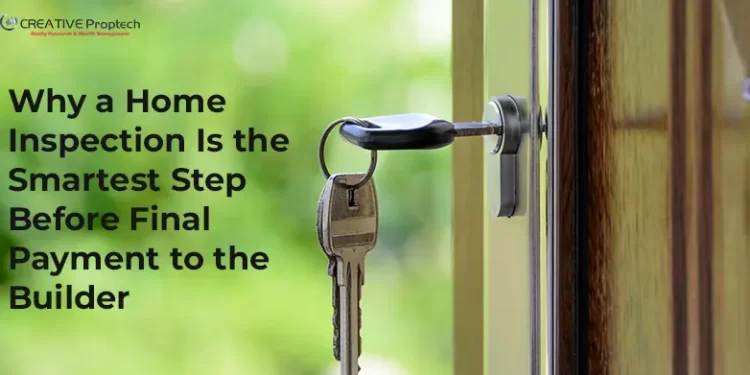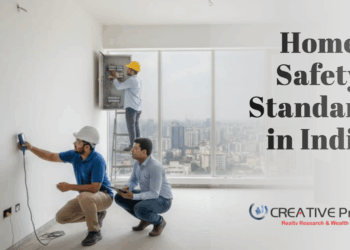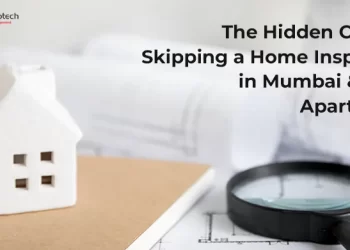For most homebuyers in India, purchasing a flat is not just a financial decision it’s an emotional milestone. After years of planning, saving, and dreaming, stepping into your own home feels like a lifelong achievement. But amid the excitement of taking possession, one critical step is often overlooked: getting a professional home inspection done before making the final payment to the builder.
Builders often assure buyers that the project meets all promised specifications, but hidden defects in construction, finishing, plumbing, or electrical systems are far more common than most people realize. Once you clear the final payment and take possession, holding the builder accountable for repairs becomes an uphill battle. That’s where a home inspection becomes your safeguard, ensuring the property you paid for truly matches the quality and safety standards you deserve.
Why a Home Inspection Before Final Payment Matters
Making the final payment is usually the last major step before complete possession. This is also the point when buyers lose significant leverage over the builder. A home inspection ensures that:
- You are paying for a quality-checked home, not a rushed handover.
- Hidden defects are identified before possession, when the builder is still responsible.
- You have a professional inspection report that can be used to negotiate repairs or corrections.
Without an inspection, you risk moving into a property with issues that may cost lakhs in post-possession repairs.

Common Issues Found in Builder-Finished Flats
Even brand-new flats in modern housing projects are not free from defects. Some of the most common issues discovered during inspections include:
- Structural & Finishing Defects
- Uneven flooring, cracks in walls, or poor plastering.
- Misaligned doors and windows that don’t shut properly.
- Improper tiling with gaps, hollow sounds, or uneven grouting.
- Plumbing Defects
- Leaking bathroom fittings or poor-quality sealants around basins.
- Improper slope in bathrooms or balconies, causing water stagnation.
- Concealed leakages in pipelines that lead to seepage.
- Electrical Safety Issues
- Loose or exposed wiring that can be hazardous.
- Overloaded MCBs (Miniature Circuit Breakers).
- Switchboards with incorrect polarity or poor connections.
- Water Seepage & Dampness
- Damp patches on walls caused by poor waterproofing.
- Leakage from overhead tanks or terrace areas.
- Improper sealing in bathrooms leading to seepage into lower flats.
- Ventilation & Natural Light Issues
- Poor cross-ventilation or blocked shafts.
- Windows installed in the wrong direction, reducing natural light.
- Safety Hazards
- Absence of proper earthing in electrical systems.
- Balcony railings installed at unsafe heights.
- Loose tiles or sharp edges in finishing that can cause accidents.
A professional inspector uses advanced tools such as moisture meters, infrared thermal scanners, and electrical testers to detect problems that are not visible to the naked eye.
How a Home Inspection Protects Your Investment
A property inspection is not just about finding problems—it’s about protecting your money and peace of mind. Here’s how it works in your favor before final payment:
- Identifies Hidden Defects
Small cracks, seepage marks, or loose wiring may not be visible during a casual walkthrough but can cause long-term damage if ignored. Inspections catch them early.
- Strengthens Your Negotiation Power
Armed with an inspection report, you can demand that the builder fixes issues before final settlement—or renegotiate the amount based on repair costs.
- Ensures Compliance with Promised Quality
Builders often cut corners during the finishing stage to speed up handovers. A home inspection ensures that all promised fittings, materials, and workmanship are delivered as committed.
- Prevents Post-Possession Expenses
Once you’ve paid and moved in, every repair cost—whether ₹10,000 or ₹1 lakh—falls on your shoulders. Inspections ensure these expenses are addressed while the builder is still liable.
- Safeguards Your Family’s Safety
Defects in electrical wiring, plumbing, or structural finishes can lead to accidents. A pre-possession inspection ensures your new home is safe and move-in ready.
Why You Should Not Delay Inspection Until After Possession
Many buyers assume they can move in first and inspect later. However, this is a costly mistake. Once the final payment is made and possession is signed, your legal leverage over the builder reduces drastically.
- Before possession: Builders are more likely to cooperate since they still await final clearance.
- After possession: Fixes are often delayed, denied, or offered as temporary solutions.
This is why a pre-final payment inspection is always smarter than a post-possession one.
The Home Inspection Process – What to Expect
When you book a professional inspection before final payment, here’s how the process usually unfolds:
- Scheduling: You book an inspection at a convenient date before making the final payment.
- On-Site Inspection: Inspectors spend 60–90 minutes (depending on property size) checking every detail—structural, electrical, plumbing, and finishing.
- Advanced Tools: Use of thermal cameras, moisture meters, and electrical testers for hidden issues.
- Detailed Report: A comprehensive, easy-to-understand report with photos of defects is shared.
- Follow-Up: You can share this report with your builder and demand corrections before clearing the payment.
Conclusion
Buying a home is one of the most important investments in your life, and the final payment to the builder is not just another transaction—it’s the point where you either secure your investment or risk future losses. A professional home inspection before final payment ensures you move into a safe, defect-free property and gives you the confidence that your hard-earned money is spent wisely.
Don’t let hidden flaws turn your dream home into a financial burden. Book a home inspection before your final payment and take possession with peace of mind.
Frequently Asked Questions
- Why should I get a home inspection before final payment?
Because this is when you still have leverage over the builder to fix hidden defects, ensuring you don’t pay for a substandard property. - How long does the inspection take?
Typically, 60–90 minutes depending on the size and complexity of your flat. - Can new flats also have defects?
Yes. Even brand-new properties can have rushed finishing, electrical faults, or waterproofing issues that only inspections can uncover. - What tools are used in inspections?
Inspectors use advanced tools like infrared thermal scanners, moisture meters, and electrical testers to detect hidden issues. - Will the builder accept the inspection report?
Most professional reports are detailed and evidence-backed, making it easier for buyers to negotiate repairs with builders before possession.






